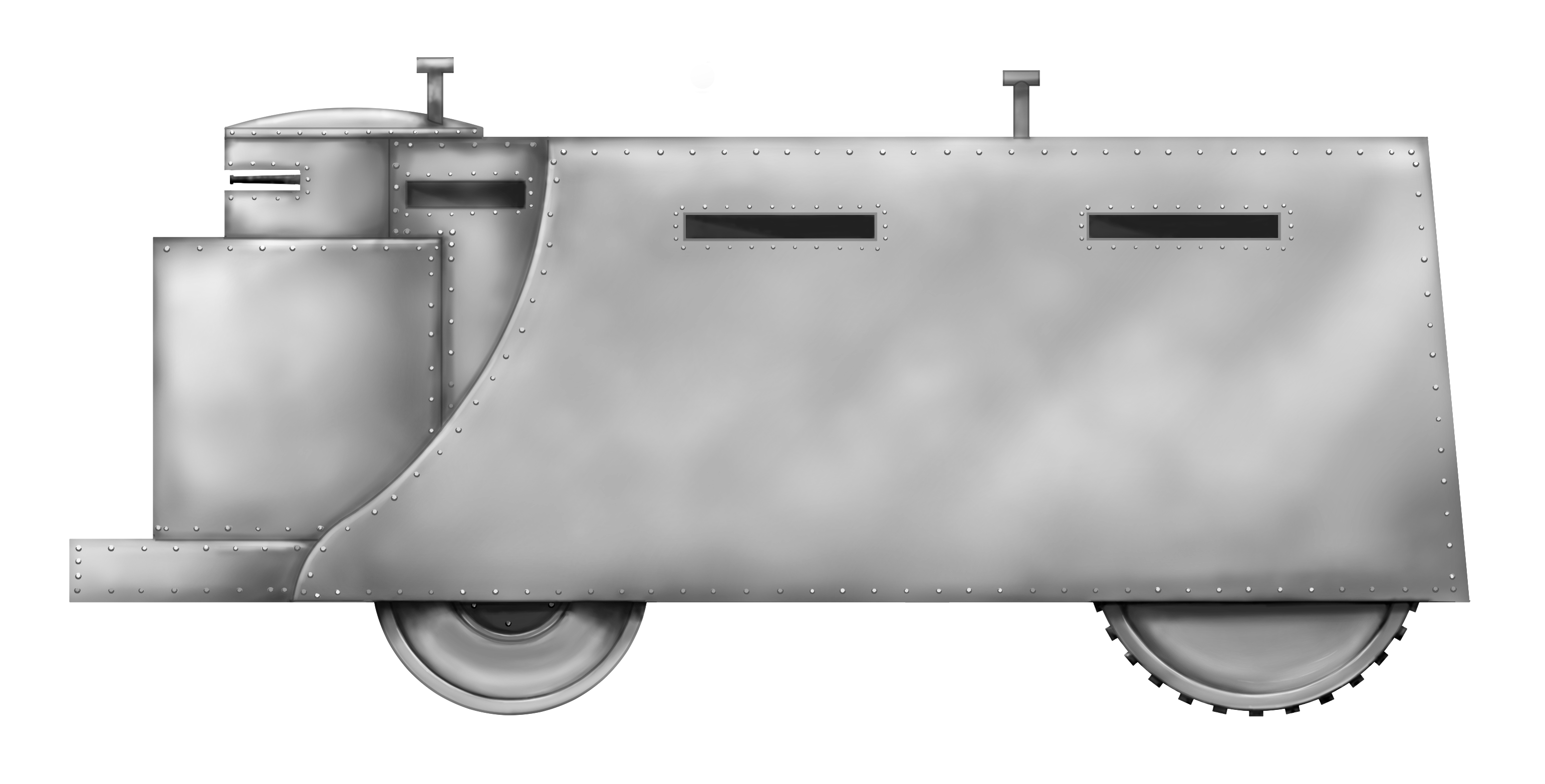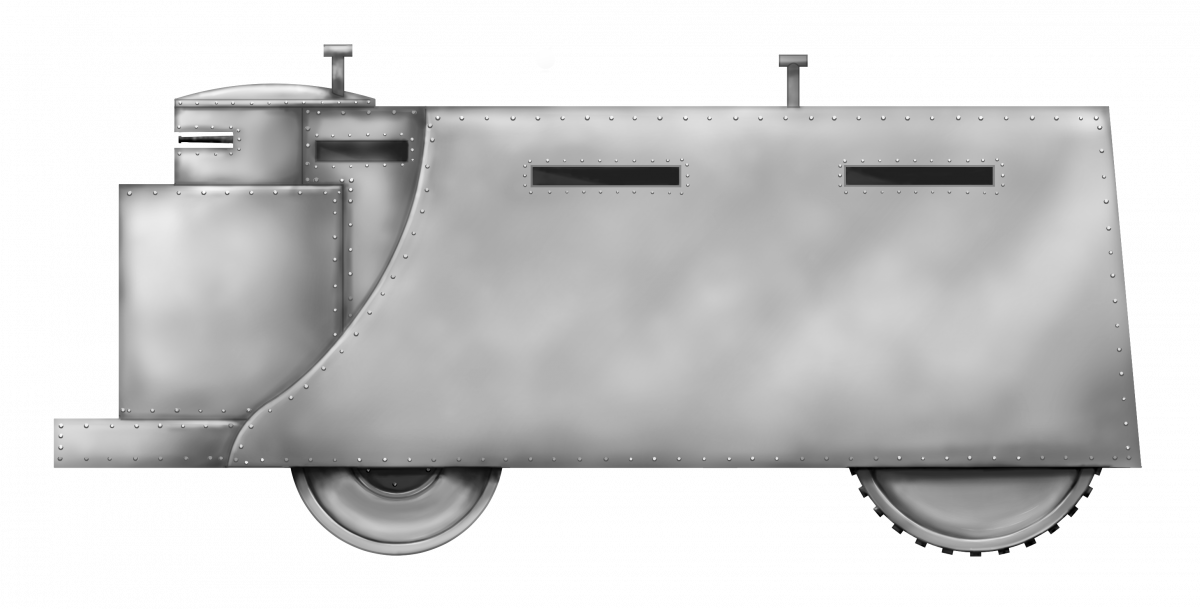 United States of America (1919)
United States of America (1919)
Armored Truck – None Built
On 29th March 1919, Joseph Treanor McNaier submitted a patent design for a centrifugal gun. This was no ordinary firearm and was not merely a design for a weapon in isolation. When he filed his design on 2nd April, McNaier was proposing a new way to consider an old idea, and one which he had improved on.
Centrifugal Gun
A centrifugal gun is a gun reliant not on the expansion of gas from a chemical propellant or other sources for acceleration, but instead on centrifugal force. Such ideas had been around since at least the early 19th century and perhaps the most famous was the Winans Steam Gun of circa 1860.
The principles of these guns are the same. It is a circular weapon in which a high speed rotor is driven by some means producing a high rotational speed within a casing. Into this a stream of ‘bullets’ in the form of metal ball bearings or musket balls from a hopper are fed. The ball/bullet is accelerated by the rotating arm within the chamber and with only a narrow point of escape flies out of that point at high speed having been accelerated by the rotating arm. This, in effect, is a weaponized version of a lawnmower striking a piece of gravel. A small high velocity object flung by the transference of energy from the arm to the ball.

Source: US Patent:1472080.
Note: image has been digitally cleaned by the author.
Certainly, McNaier was not claiming to have invented a centrifugal gun, more an improvement upon one. For example, rather than simple solid balls of metal (lead or steel), he proposed the option of a small explosive-filled ball as a bullet. Further, his design altered the feed of the bullets to come from a hopper above or below the rotating arms in such a way as to avoid jamming the mechanism as they were fed into the breech. By way of showing the potential value of his design, McNaier provided two possible mountings for it for use by the military. The first was on an armored truck and the second was on an airplane.
The Man
The patent for the centrifugal gun was filed in the name of Joseph Treanor McNaier of New York. Treanor was born in New York on 4th April 1875, the son of Walter and Emily McNaeir. He was 44 when he filed his design and also a practicing attorney as a graduate of New York University Law School in 1915. His US military draft card of 1917 states that he was a lawyer by trade residing at 256 West 108th Street, an apartment complex not far from New York’s Central Park.
Doing his part for the USA in WW1 (1914-1919), he registered for the draft and was called upon to serve as a captain within the Judge Advocate General’s Department assigned to the Survey Office within Maritime Affairs in 1917. He was discharged from US military service on 30th June 1920 following a period of sickness beginning in May that year. He survived his illness, which was possibly connected to the flu at the time, as he was back to work at least into 1926 as a solicitor in New York at his family business ‘McNair and Moore’ based in office 2122 at 233 Broadway, New York., – the iconic Woolworth Building.
The Truck
The truck, as drawn by McNaier, would, in plan view, appear as a rectangle with the lower part at the front rounded and the upper part at the front forming a triangle. Between these two was a pair of cylindrical towers blended into the sloping front armor, with the upper of the two smaller and projecting slightly above the level of the flat roof. Surmounted by a low domed roof, the only notable feature on the top of this turret was a single periscope. The lower cylinder was part of the hull, but this upper cylinder formed a turret which could rotate within the larger cylinder below it.
In the two faces of the triangle on the front were a pair of rectangular slots for observation, with one on each side of the cylinders. In the face of the upper cylinder was another slot, although this one was for the centrifugal gun, not for observation.

Source: US Patent:1472080.
Note: image has been digitally cleaned by the author.

Source: US Patent:1472080.
Note: image has been digitally cleaned by the author.
The rest of the truck itself was somewhat plain. Vertical armored sides, a horizontal flat roof, and a slightly inclined rear. The vehicle ran on four wheels, with the rear wheels clearly drawn larger than those at the front. The drawing of the vehicle provides an ‘x-ray’ type view inside and therefore obscures some design ideas from the part cut-away, such as a possible access door or observation slot in the left-hand side. There is, however, one more vision slot drawn in the rear right-hand side of the hull, directly over the line of the rear wheel. No transmission or engine is proposed or mentioned by McNaier.
This slot appears to line up with the driver’s seating position, which would compete as potentially the most comfortable position for an armored vehicle, appearing more like a couch than a seat. Sat on this couch, the driver controlled the direction of the vehicle by means of a steering wheel connected to a large box affixed to the floor of the vehicle. No pedals or levers are shown.

The Airplane
The airplane offered two possible mounting ideas for a centrifugal type weapon on top and below the fuselage, at the rear and front of it, respectively. Powered by a directly connected transmission shaft from the engine, these centrifuge guns would have been able to spray a large volume of bullets forwards or backwards. In these contexts, accuracy, the main problem with such guns, would be obviated somewhat by the nature of ground-strafing or fending off an unfriendly aircraft behind it, where a wider dispersal than normal bullets might have been advantageous.

Note: image has been digitally cleaned by the author.
Summary
Neither the truck nor the airplane seem to have been connected in any way, shape or form to McNaier’s own military service, nor his life experience. It is unclear where his ideas for these weapons may have come from, but there were certainly other centrifugal gun ideas around at the time and before from which he may have drawn inspiration. The drawing of both the truck and the airplane are basic and somewhat crude. The truck, afterall, is little more of a suggestion that a normal truck be used along with a front-and-center-mounted turret for his gun. For that matter, the gun itself is also rather redundant. It is hard to see what advantages a centrifugal gun might have over a readily available, smaller, and simpler system in the form of a machine gun. The centrifugal gun might have a veritable abundance of ammunition from its large magazine, but spherical objects are not as ballistically efficient as a bullet shape, they are also not ans accurate, not to mention that they are being fired from an open chamber rather than through a rifled barrel to spin them for stability. Less accuracy and lower range cannot be effectively overcome with just ‘more’ being used.
McNaier maybe had something on offer for his aircraft use of the gun, where such dispersal was less of a problem in the chaos of a dogfight. There were already plenty of machine guns and simply adding a second one could beat out any minor advantage his design might have had.
McNaier sadly provided no details of the engine, the armor (presumably bulletproof), performance, or a particular utility for his vehicle either for the Army or perhaps the police for riot control.
Either way, it is likely no surprise that the truck was never built and McNaier seems to have had a successful legal practice to rely on, so perhaps he did not need to trouble himself too much more with ideas of firearms anyway.

Specifications McNaier Armored Truck |
|
|---|---|
| Crew | 2 gunner, driver |
| Dimensions | u/k |
| Propulsion | u/k |
| Armor | bulletproof? |
| Armament | centrifugal gun |
| Speed | u/k |
Sources
Bender’s Lawyer’s Diary, State of New York, 1916-1920.
New York Herald, 9th October 1921, Page 3.
New York Supreme Court, Papers of Appeal Appellate Division First Department, 1925.
New York University Catalog, 1915-1916. New York, University.
US Census 1880 ED94, Page 40.
US Draft Registration Cards 1917-1918, New York City No. 134, Serial 510, Order no. 857.
US Officer Muster Roll 1916-1939. Hayes-Holabird Post. Reel 132.
US Patent US1472080 ‘Centrifugal machine gun and method of feeding same’, filed 2nd April 1919, granted 30th October 1923.
US Veterans’ Bureaus service index card, film 105256134. NARA microfilm 76193916.
WW1 Roster of Officers, Hayes-Holabird Post. Reel 132. Monthly Officers’ Roster, Port of Embarkation at Hoboken, N.J. dated 15th June 1920.


3 replies on “McNaier’s Armored Truck”
Has anyone calculated, what muzzle velocity a centrifugal gun can reasonably reach, given the powersource and dimensions of McNaiers truck?
Shouldn’t this article be grouped with the other US ww1 prototype and project articles instead of the US ww1 tank articles since this was never built?
My knowledge in physics is somewhat rusted, but wouldn’t these guns act like gyroscopes? This would make the behaviour of the plane during a dogfight while “firing” the centrifugal guns rather interesting!